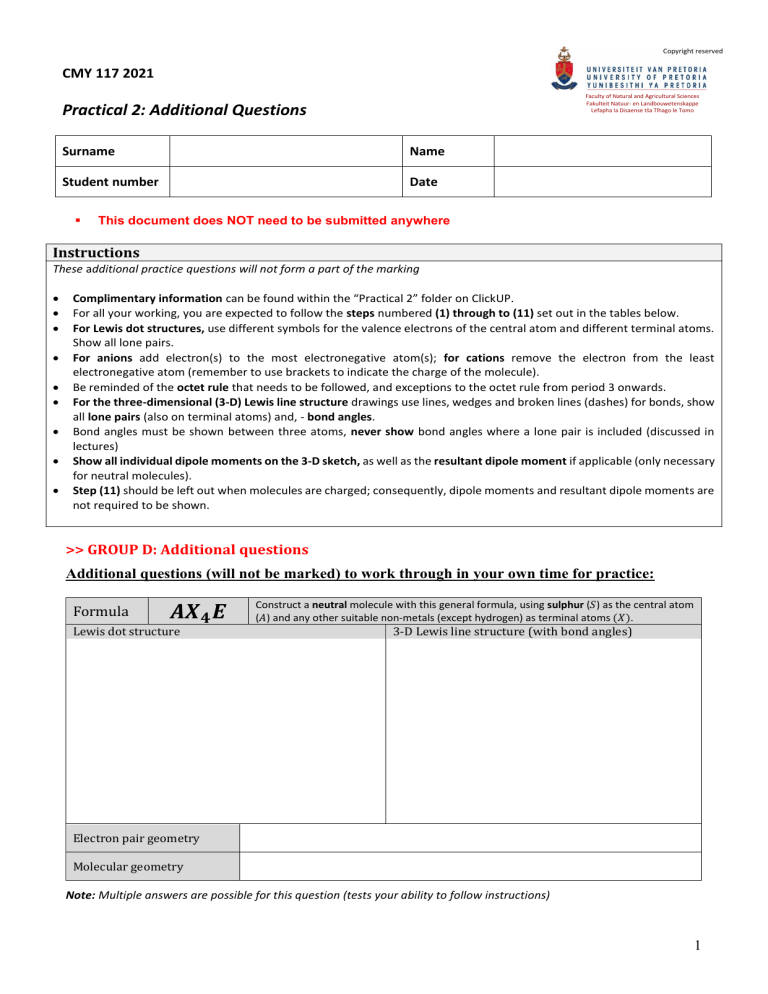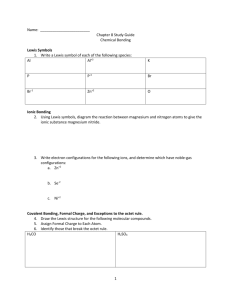
Copyright reserved CMY 117 2021 Faculty of Natural and Agricultural Sciences Fakulteit Natuur- en Landbouwetenskappe Lefapha la Disaense tša Tlhago le Tomo Practical 2: Additional Questions Surname Name Student number Date ▪ This document does NOT need to be submitted anywhere Instructions These additional practice questions will not form a part of the marking • • • • • • • • • Complimentary information can be found within the “Practical 2” folder on ClickUP. For all your working, you are expected to follow the steps numbered (1) through to (11) set out in the tables below. For Lewis dot structures, use different symbols for the valence electrons of the central atom and different terminal atoms. Show all lone pairs. For anions add electron(s) to the most electronegative atom(s); for cations remove the electron from the least electronegative atom (remember to use brackets to indicate the charge of the molecule). Be reminded of the octet rule that needs to be followed, and exceptions to the octet rule from period 3 onwards. For the three-dimensional (3-D) Lewis line structure drawings use lines, wedges and broken lines (dashes) for bonds, show all lone pairs (also on terminal atoms) and, - bond angles. Bond angles must be shown between three atoms, never show bond angles where a lone pair is included (discussed in lectures) Show all individual dipole moments on the 3-D sketch, as well as the resultant dipole moment if applicable (only necessary for neutral molecules). Step (11) should be left out when molecules are charged; consequently, dipole moments and resultant dipole moments are not required to be shown. >> GROUP D: Additional questions Additional questions (will not be marked) to work through in your own time for practice: Formula 𝑨𝑿𝟒 𝑬 Lewis dot structure Construct a neutral molecule with this general formula, using sulphur (𝑆) as the central atom (𝐴) and any other suitable non-metals (except hydrogen) as terminal atoms (𝑋). 3-D Lewis line structure (with bond angles) Electron pair geometry Molecular geometry Note: Multiple answers are possible for this question (tests your ability to follow instructions) 1 Group A&B-type questions: AsCl4 BrO2F SF6 NO2F IF2 ICl2 SnCl2 H3O + ClO2 IO2 TeCl4 CO3 2 SnCl2 NOCl XeO4 AsH3 IO2F2 SFO3 BeF2 COS SeOF2 XeS2O2 NO3 NH2 - SbCl3 SiF6 2 BiCl4 + SeO4 2 AsBr2Cl SO3 SCN CHIBrCl HIO2 HNO2 Group C-type questions: HClO4 HNO3 2





